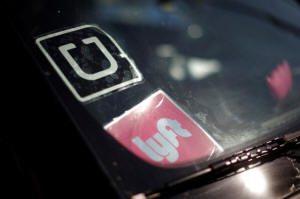|
Driving a hard bargain
for taxes
 Send a link to a friend
Send a link to a friend
 [February 18, 2017]
By Kathy Kristof [February 18, 2017]
By Kathy Kristof
LOS ANGELES (Reuters) - Lured by the
promise of high pay for part-time work, Geovanie Rosario quit his day
job three years ago and joined the so-called “gig economy.”
Driving for Lyft, Uber and other ride-hailing services in New York, he
took home a tidy $69,000 in his first year – vastly more than what he
had earned previously as the assistant manager of a furniture store.
The catch for Rosario and millions of other people who have embraced the
notion of being their own boss is that the cost of running a business
can be substantial. Rosario had to lease a car; buy auto and health
insurance and pay for gas, tolls, snacks and water bottles, among other
things.
The bright side is that most of those expenses are deductible at tax
time, as long as you take the time to learn the tricky tax rules that
affect the self-employed. Less fun for most people is that you need to
estimate early in the year how much you will owe at year-end and pre-pay
that amount in quarterly installments.
The Internal Revenue Service publishes a 51-page booklet
(https://www.irs.gov/pub/irs-pdf/p334.pdf) attempting to explain both
tax obligations and deductions for people who work for themselves. Among
the negatives: You must pay self-employment taxes to both Social
Security and Medicare on your business income, and that can wipe away
15.3 percent of net earnings.

However, your taxable business income is likely to be vastly less than
your revenues, thanks to a variety of deductions, including half of the
Social Security and Medicare taxes you pay, as well as some expenses
some of which have no immediate out-of-pocket cost.
For instance, if you bought a car to drive for Uber, you can write off
up to $11,160 that year in “depreciation” – essentially the decline in
value of a business asset - even if you financed the purchase and did
not pay that much of the car’s cost upfront.
Additionally, auto insurance costs are deductible if you use your car
for ride-share services. Your write-off would amount to the annual cost
multiplied by the percentage that you use the car for work. So, if you
pay $3,000 and the car was 90 percent dedicated to the business, you
would be able to write-off $2,700.
If, like Rosario, you have no employer-paid health insurance, the health
insurance premiums paid for both yourself and your family are also fully
deductible as business expenses.
Life, disability and long-term care insurance premiums also are
generally deductible for the self-employed.
[to top of second column] |

A driver displays Uber and Lyft ride sharing signs in his car
windscreen in Santa Monica, California, U.S., May 23, 2016.
REUTERS/Lucy Nicholson/Files

DEDUCTING WATER, SNACKS AND SPOTIFY
If you buy meals, gifts or take clients - even potential clients - to concerts
or sporting events, the cost of the entire evening is deductible.
Though Rosario did not treat clients to meals, he initially stocked his car with
snacks, water bottles, magazines, newspapers and two tablets loaded with Spotify
that customers could use to create custom playlists for their rides. He figured
the perks would boost his driver ratings, and thus, secure more work.
There are few bright lines delineating what is deductible and what is not for
business owners, says Philip Holthouse, partner at the Los Angeles accounting
firm of Holthouse Carlin & Van Trigt. But keep good records, because small
business owners are more likely to be audited than taxpayers who earn only
wages.
When trying to figure out whether an expense could be deducted, Holthouse
recommends asking yourself, "Can you say, with a straight face, that you [spent
this money] because you were hoping that some business would come out of it? If
so, it could be deductible."
One big exception: You cannot deduct traffic and parking tickets, says Mark
Luscombe, principal tax analyst with Wolters Kluwer Tax & Accounting. "The
government doesn't want to reward people for bad behavior."
As for Rosario, in that first year of driving, his deductions were so high that
his taxable income amounted to a mere $21,000. That lowered his tax burden, he
notes, but all those work-related expenses left him with little to live on. He
has since cut out a lot of the frills, but competition among ride-hailing
services has increased, so it's tougher to generate revenue.

Rosario has not yet completed his 2016 return, but hopes that cutting his
expenses will help his bottom line.
(Editing by Beth Pinsker and Andrew Hay)
[© 2017 Thomson Reuters. All rights
reserved.] Copyright 2017 Reuters. All rights reserved. This material may not be published,
broadcast, rewritten or redistributed. |